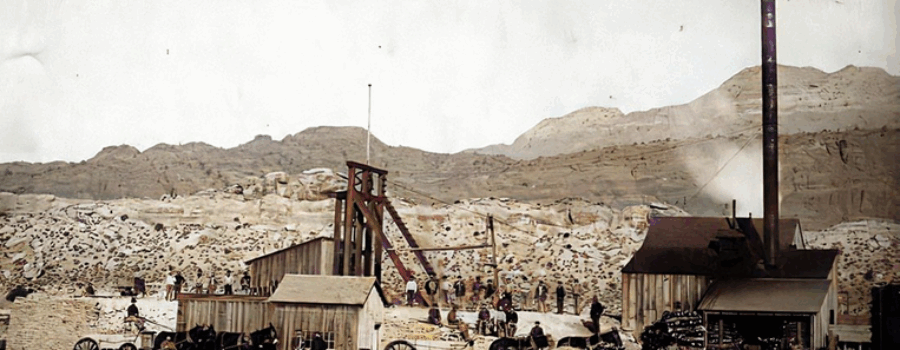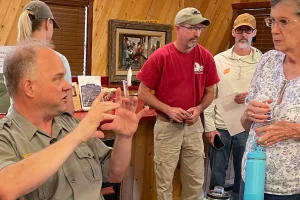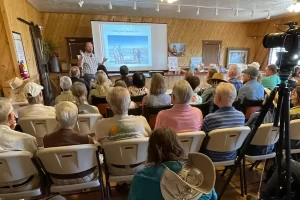Written by Ron Carberry – April 2025
Next year will mark the 150th anniversary of the birth of the long-abandoned mining town of Silver Reef near Leeds, Utah. Silver Reef is unique because it’s the only place on earth where silver has been commercially mined from sandstone. It’s well documented that John Kemple was the first to discover silver in sandstone near Harrisburg, Utah in 1866. However, nobody believed him at the time, since silver in sandstone was considered to be geologically impossible.

Kemple was an experienced prospector, but he was not prospecting at the time of his discovery. He was traveling from Montana to Nevada with a string of horses when he arrived in Harrisburg. He decided to rent a room in Orson Adams’ house for the winter. He worked as a blacksmith on the Adams farm while his horses grazed nearby. Like everyone else, Kemple believed that gold, silver and other heavy metals could only be found in hard rocks like granite or quartz – and there was nothing but sandstone all around him.
One day, he noticed a peculiar stone lying in a dry wash at the base of the White Reef near the Adams farm. It was a piece of white sandstone with dark gray streaks. The color of the streaks possibly indicated silver chloride (a.k.a. horn silver). So, he pocketed the stone to extract a sample and assay it later. When he assayed the sample, the result shocked him. Not only was there silver in the sandstone, but he found a high concentration of the valuable mineral.

Being a stranger in town, Kemple found it nearly impossible to persuade anyone that his claim was authentic. After all, everyone knows that there’s no such thing as silver in sandstone. He sent ore samples from the White Reef to various assayers in the area to confirm his findings, but to no avail. One assayer refused to assay the samples and claimed that “Kemple must be crazy to ask me to assay a sand rock.” Another assayer accused Kemple of “salting” or his sample to achieve a false positive result.
Kemple moved on to greener pastures in Nevada in the spring of 1866, but he returned to Harrisburg periodically over the next several years. He dug an exploratory shaft on the White Reef in 1870 and found more silver ore. In 1871, Kemple organized the Harrisburg Mining District and staked his claim on the White Reef. Some local farmers staked claims as well. Among them was Elijah Thomas, one of the founding settlers of St. George, which was named in honor of his old business partner, George A. Smith. Smith was popularly called the Potato Saint for his generosity with that crop to poorer brethren. In 1873, Elijah Thomas and a friend, John “Rattler” Ferris, discovered a crevice in the White Reef that appeared to contain silver ore. They staked a claim, which was later jumped by a gang of angry miners who threatened to kill them if they returned!
In 1874, Elijah Thomas sent samples of silver ore from the White Reef to the Walker brothers in Salt Lake City. Apparently, he did this before his claim was jumped. An assayer from the Smithsonian Institute then confirmed that there was a high concentration of horn silver in the samples sent by Thomas. Eight years after John Kemple found silver in the White Reef sandstone, his discovery was finally authenticated.
Alternative discovery stories began to circulate during the 1870s. For example, there’s the story of the weeping fireplace. In this tale, an unnamed traveler takes winter refuge in a Leeds home before Silver Reef existed. While warming himself beside a roaring fire, he noticed large droplets of silver weeping from the sandstone fireplace. He found the quarry from where the sandstone was taken, purchased the land and later made a fortune.
Another discovery story was dramatized in an episode of the TV show Death Valley Days in 1955. Death Valley Days S3E15 The Mormon’s Grindstone This is the story of Metalliferous Murphy. His real first name is unknown. He was a new assayer in the silver mining town of Pioche, Nevada in 1876. After a while, he became the subject of ridicule in town because he always found higher quantities of silver in local granite ore samples than did his competitors. His defense was to brag that he had been trained in the best schools in Scotland. Some miners thought he was too cocky. They suspected that he was falsifying the results of his assays to gain more business. Thus, they derisively called him Metalliferous Murphy, the assayer who could find silver in dandelions.
As the story goes, a practical joke was devised by some of the miners to expose Murphy as the fraud they believed him to be. They took a piece of a broken grindstone from Leeds to Metalliferous for a silver assay. The joke was that the grindstone was made of sandstone, and everyone knows that there’s no such thing as silver in sandstone. Murphy performed the assay and dutifully reported that it contained over 20 ounces of silver per ton, which made it high grade ore.

Some say that Metalliferous Murphy was hanged on the spot. Others claim that he was tarred & feathered and run out of town on a rail. One happy ending of the story is that he traced the origin of the grindstone to Leeds, where he promptly went to locate his claim and became fabulously rich. In the Death Valley Days episode, seven angry miners threaten to tar and feather Murphy, but they allow him to perform the assay again while they watch with guns drawn.
A less dramatic story of who discovered silver in sandstone involves a man named Shepard from Leeds. Again, his first name is unknown. Sometime before Silver Reef began in early 1876, Shepard carried some white sandstone samples from the Leeds-Harrisburg area to Hyman Jacobs, a prominent merchant in Pioche. Shepard convinced Jacobs that high grade silver was in the sandstone. Jacobs sent the samples to a metallurgist named Professor Janney and a civil engineer named Charles Hoffman in California.
After obtaining favorable silver assays, Janney and Hoffman journeyed to Pioche to determine the origin of the unusual samples. Jacobs took both men to the Harrisburg-Leeds area, where they collected more samples and returned to Pioche to have them assayed for silver. Janney and Hoffman were so amazed at the positive test results that they suspected the samples had been salted. So, they assayed the samples themselves but achieved the same result.

Jacobs saw a new silver boom in the making. He immediately moved his entire mercantile operation from Pioche to the new strike site in Utah. Hoffman returned to California to obtain financial backing. With this money and Jacobs’ assistance, he bought mining property north of Leeds and then helped to organize the Leeds Mining Company of San Francisco in 1876.
A dangerous competition to authenticate the discovery of silver in sandstone was developing in the early 1870s. John Kemple and his competitors knew that being the first to discover it doesn’t mean much until wealthy investors are willing to risk a lot of money to mine the silver ore and process it. As it turned out, the Walker brothers were those investors.

The Walker brothers were Salt Lake City bankers from one of the wealthiest families in the Utah Territory. In 1875, after receiving the Smithsonian Institute assayer’s finding of silver in the samples sent by Elijah Thomas, they sent William Tecumseh Barbee and two others to examine the White Reef. Barbee had published several books, including “The Physical and Moral Aspects of Geology” (Philadelphia 1859). He became enthused when he found silver “even in petrified wood” and a “piece of petrifaction onto which the native silver was sticking like globules of pine gum.” Barbee located 22 claims on the nearby Buckey Reef and hurried back to Salt Lake City for more supplies.
When Barbee announced his discovery of silver in sandstone, he received nothing but derision in Salt Lake City. However, when his letters were published in the Salt Lake Tribune, the boom was on! Barbee returned to southwestern Utah to establish a town site just north of the Buckeye Reef, which he named Bonanza City. But the land he offered for sale there was so expensive that a tent city arose on unclaimed land nearby, which was jokingly called the Rockpile.
By 1876, news of the Barbee-Walker claims was spreading like wildfire. During this time period, the silver mines in Pioche were not producing to the point that the mines were closing, and many miners were unemployed. When they heard the news, many if not most of the Pioche residents packed up their belongings, including their houses, and moved to the Rockpile. This migration became known the Pioche Stampede. About 1,000 people populated the Rockpile in 3 months. The Rockpile and Bonanza City were renamed Silver Reef City later in 1876.
All of these stories about who discovered silver in sandstone were circulated during the eight years when John Kemple was trying to authenticate his claim or thereafter. Since Kemple was an experienced prospector, he must have known that others were noticing the same oxidized metal colors in the white sandstone that he was noticing. He also must have known that he was competing against others with more resources and connections to be the first to authenticate his claim. It’s a testament to his character that he was able to persevere and remain undaunted for so long when nobody else believed him. Though he did not supply the silver ore samples that were authenticated first, John Kemple deserves the credit for being the first to discover silver in sandstone.

Elaine Young, Silver Reef Museum Historian, contributed to this article.





